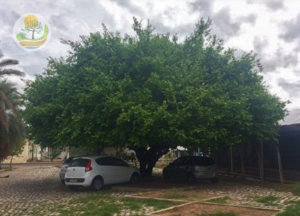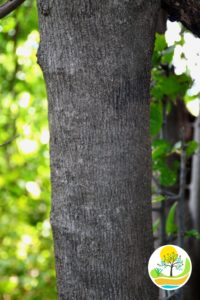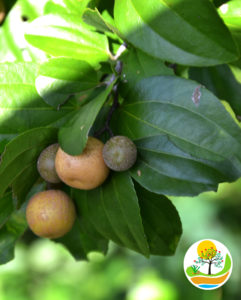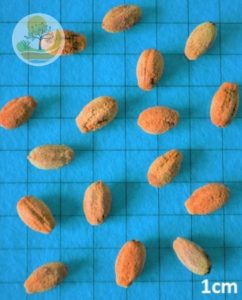General information
Summary description
Ziziphus joazeiro is present in the Caatinga, widely known for its fruits and, especially, for providing vast shadow throughout the year.
Scientific nomenclature
Ziziphus joazeiro Mart.: Magnoliophyta (Angiospermae); Class Magnoliopsida (Dicotyledonae); Order Rhamnales; Family Rhamnaceae; Genre Ziziphus.
Botanical synonym: Ziziphus guaranitica Malme, and Ziziphus gardneri Reissek (CARVALHO, 2017).
Local names
Joá, joazeiro, juá, juá-bravo, juá-de-boi, juá-espinho, juá-fruta, juá-mirim, laranjeira-de-vaqueiro, and loquiá (named by a native people known as carijó ) (MAIA, 2004).
Cultural and economic importance
The juazeiro is used for forest restoration and in agroforestry systems. A tree with good characteristics for beekeeping; also used in city landscaping for its large crown and wide shadow. Its leaves stay green all year round and, together with its fruits, are widely used as forage for goat, sheep, swine, and even dogs.
It is also a tree used to produce firewood (CONCEIÇÃO and PAULA, 1986). Wood from this species is used, locally, for many purposes, such as in tool handles, pack saddles, wood nails, in rural buildings, posts and woodwork (CARVALHO, 2007).
Ecological importance
A perennial plant, exclusive from lowland in the semiarid (Caatinga). Its deep root system allows it to remove water from the subsoil to keep its green leaves through the dry season.
Phenology
The joazeiro keeps its leaves green throughout the year, reducing its foliage in drier years or before the start of flowering. The plant may lose their leaves in dry seasons. They renew its foliage in October when the dry season is at its peak. Flowering occurs at the end of dry season and the beginning of the raining season. Fruits start during the raining season (MAIA, 2004).
Geographical distribution
Natural from Brazil, in the states of Bahia, Ceará, Maranhão, Minas Gerais, Paraíba, Pernambuco, Piauí, Rio Grande do Norte, Sergipe, Mato Grosso, Mato Grossod o Sul e Rondônia (CARVALHO, 2017).
Botanic description
Size, crown shape, color, growth habit
10 meters height, spinescent. Trunk of up to 60 cm (2 ft) in diameter, short and very branched. Globose crown in dark green.
Vegetative characteristics
- Trunk and bark
Branched, dark gray/slightly brown and smooth bark. Flexible branches, brownish, striated. The older branches are in cylindrical form, grayish and with lenticels. Hard thorns, generally straight, arranged in pairs at the axillary buds (SALOMÃO; ALLEM, 2001).
- Leaves
Alternate lustrous leaves; membranous or coreaceous, oval or elliptic, glabrous in both sides (rare hairy down surface). Acuminate tip.
- Flower/inflorescence
Flowers of 4-6 mm in length, yellow-greenish, pedicellate, pubescent, monoicous, five sepals, five petals, dialipetal.
- Fruit, seeds and dispersal syndrome
Fleshy fruit, yellow or beige, drupe, average length of 1.5-2 cm (.6 to .8in), globous, slightly rough.
Seeds are covered by the hard endocarp and wrapped in a white mucilaginous pulp (LORENZI, 2000). Low polyembryony rate (2%) (SALOMÃO; ALLEM, 2001). Produce a large number of viable seeds annually, which are disseminated by animals (LORENZI, 2008).
Seed technology
Germination
Germination occur within 10 and 100 days after sowing (LORENZI, 1992). Low germination rate.
Seed storage
Short viability after storage. No more than 5 months in storage (LORENZI, 1992).
Seed health
Microorganisms may be present on the surface or inside the seed. Aspergillus niger is one of these microorganisms, air-saprophyte fungi, which may cause damages to the seed, such as rot, discoloration of tegument, and reduction of germination (FERREIRA, 2007).
Seedling production
Growth capacity
Slow seedling growth. Ready for transference to the field after 8-9 months. In the field, it has fast growth, reaching 3 m (9.8 ft) when 2 years old (LORENZI, 2009).
< Go back to main page >
REFERENCES
- CARVALHO, P. E. R. Juazeiro – Ziziphus joazeiro. Embrapa, Colombo, PR. Embrapa Florestas. Circular Técnica 139, 2007.
- CONCEIÇÃO, D. de A.; PAULA, J.E. de. Contribuição para o conhecimento da flora do pantanal mato-grossense e sua relação com a fauna e o homem. In: SIMPÓSIO SOBRE RECURSOS NATURAIS E SÓCIO-ECONÔMICOS DO PANTANAL, 1., 1984. Corumbá. Anais. Brasília: EMBRAPADDT, 1986. p.107-136. (EMBRAPA-CPAP. Documentos, 5).
- FERREIRA, K. C. Uso do Extrato de Piper nigrum (pimente-do reino) na redução da incidência de Aspergillus niger em sementes de Pseudobombax margarinatum (embiratanha). 2007. 22f. Patos, PB Monografia – Universidade Federal de Campina Grande, Patos-PB.
- LORENZI, H. Árvores Brasileiras: Manual de Identificação e Cultivos de Plantas Arbóreas Nativas do Brasil, vol.2. 3. ed. Nova Odessa: Instituto Plantarum, 2009. 384p.
- LORENZI, H. Árvores brasileiras: manual de identificação e cultivo de plantas arbóreas nativas do Brasil. Nova Odessa: Ed. Plantarium, 1992. 352p.
- MAIA, G. N. Caatinga: árvores e arbustos e suas utilidades. 2. ed. Fortaleza-CE: Printcolor Gráfica e Editora, 2012.




